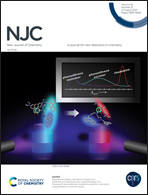Improved ionic diffusion and interfacial charge/mass transfer of ZIF-67-derived Ni–Co-LDH electrodes with bare ZIF-residual for enhanced supercapacitor performance†
Abstract
MOFs (metal–organic frameworks) are ideal precursors for constructing hierarchical structures utilized for energy storage, gas separation/capture, and waste adsorption. ZIF-67, a widely used MOF, can be converted to a Ni–Co-LDH battery-type electrode in Ni(NO3)2 ethanol solution for supercapacitor application. Herein, ZIF-67 was treated with Ni(NO3)2 ethanol solution at different soaking time periods. All products exhibited hierarchically porous hollow nanocages and were characterized to illustrate the conversion process and the effects of ZIF-residuals on the electrode performance. The results indicated that the ZIF residuals drastically influenced the ionic diffusion efficiency of electrolyte ions within the electrode and faradaic resistance between the electrolyte/electrode interfaces. The optimized Ni–Co-LDH-4.5 h electrode presented a remarkable charge storage behavior with a specific capacity of 732 C g−1 at the current density of 1 A g−1 and maintained its 68.3% capacitance (500 C g−1) at 25 A g−1. The fabricated all-solid state asymmetric supercapacitor presented a remarkable energy density of 45.33 W h kg−1 at the power density of 395.13 W kg−1. The cycling test indicated that 78.55% of the initial capacitance was retained after 8000 cycles, illustrating the remarkable long-life performance.



 Please wait while we load your content...
Please wait while we load your content...